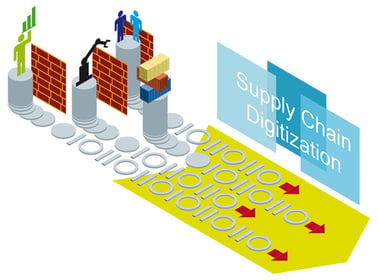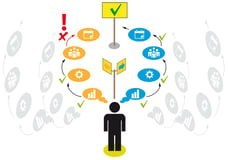The Manufacturer’s Guide to Digital Transformation
Brian Hoey - February 27, 2020

 For a recent report, McKinsey tracked the progress of a group of Industry 4.0 “Lighthouses,” i.e. operations that had successfully undergone or were undergoing digital transformations in the spirit of the Fourth Industrial Revolution. So far, these manufacturers have been fairly successful at creating a smarter end-to-end value chain, and their agility, productivity, and waste reduction have by and large shown real improvements as a result.
For a recent report, McKinsey tracked the progress of a group of Industry 4.0 “Lighthouses,” i.e. operations that had successfully undergone or were undergoing digital transformations in the spirit of the Fourth Industrial Revolution. So far, these manufacturers have been fairly successful at creating a smarter end-to-end value chain, and their agility, productivity, and waste reduction have by and large shown real improvements as a result.
This is, of course, an encouraging sign for anyone who’s been following along as the manufacturing industry changes and evolves. At the same time, McKinsey did find a worrying trend: The gap between leading Industry 4.0-enabled operations and the rest of the pack was growing. To wit, they found that 70% of companies in the manufacturing space were lagging behind—many of them stuck in “pilot purgatory,” with new technology implementations failing to yield measurable ROI.
The upshot here is that there’s a long way to go in terms of digital transformation within the larger manufacturing space. Companies that are lagging behind need to take a more systematic approach to creating value with digital technology. If they can do that, they stand to improve their agility and make their entire operations smarter; if they can’t, they could get left behind.
Digital Transformation in the Manufacturing Industry
If you’re one of the 70% of companies that are lagging behind—or even if you’re successfully digitizing and wondering how to maintain that competitive edge—it can be helpful to get a refresher on what, exactly, digital transformation means in an industrial context. It can be notoriously difficult to field a single definition of the term (since it means different things to different people), but for our purposes we'll think of it as building out networks of digital technology to handle processes that used to be done manually. If we want to get really wonky, we can divide this into two stages:
- Digitization: turning analog data into digital data, e.g. storing all of your past customer orders and production plans in a server that can be accessed by users as needed.
- Digitalization: creating computer-powered processes to handle value chain activities that were previously done by hand, e.g. using a piece of software, rather than pen and ink, to create a demand forecast for the upcoming quarter.
People often use these terms interchangeably (or use digitization as a catchall for both concepts), but the distinction is crucial to understanding the digital transformations that lie at the heart of Industry 4.0.
Why? Because true digital transformation requires you to do both, in sequence or in parallel. Thus, where you might once have received paper order slips, which were then stored for use by production planners who would figure out the production ratios for the next month on a piece of graph paper, today you might implement a storage system for this information that integrates with your planning software. In this new scenario, your customers would place their orders through a digital portal, those orders would be accessible on an internal interface, and your production planners would import those orders directly into planning software that helped them to optimize their production plans for the coming weeks or months.
Power to the People
Digital transformation of the sort we’re talking about can, obviously, extend far beyond the boundaries of production planning. And, in fact, its aim should be to extend to the entire end-to-end value chain—a single pocket of digitization does not a transformation make. But once you’ve gotten smart, digitalized workflows for receiving orders, placing supplier orders, planning production flows, arranging transport logistics, invoicing, etc., where does the ROI actually come from?
Contrary to how it might seem, digital processes on their own don’t guarantee operational improvement. Rather, they’re able to power ROI by giving human workers the tools and insights they need to do their jobs more effectively. This is an especially crucial point to keep in mind when reskilling or managing a workforce that might be wary of digital technology. Instead of replacing a human production planner, a digitalized production planning workflow would give that planner the tools to find the optimal plan faster than ever. This plan would be based on live, incoming data from every touchpoint on the value chain, and so it would be maximally responsive to changing conditions on the factory floor, in your suppliers’ warehouses, and in your customers’ showrooms. In this way, a logistics planner might find a backhaul opportunity that saves freight costs, or a production planner might eliminate a wasteful or inefficient element of a job shop process. Critically, these new plans would be made immediately visible to others in the operation, so that they could keep their own plans up-to-date as well.
Your Digital Transformation Roadmap
Hopefully by this point you’ve gotten a sense of what the end result of a digital transformation could look like—and from there you can imagine how these digital processes could integrate with new data sources like IoT devices and things like AI and advanced analytics to bring you closer than ever to Industry 4.0. What might be less clear, however, is how to make this transformation happen.
At the risk of over-simplifying, here’s something of “roadmap” you can use to get started on doing just that:
- Audit your data storage and planning workflows: Where are you storing things like past orders, how are incoming orders sorted, where can you find current inventory information? Who makes which plans, and where are those plans stored? This will give you a good baseline for where you need to digitize.
- Identify opportunities for digitization: Are any of your important caches of data still stored on paper? Are you working out incident management scenarios on the back of an envelope? Wherever you’re still doing things “the old fashioned way,” you can earmark those particular areas for transformation.
- Consider potential software/hardware options: Eventually, you’ll want to choose a software provider (or multiple software providers) to help power your digital processes. You can either start with one area of your business and then expand out from there, or you can take a more top-down approach—but in either case you’ll need to have an idea of how different pieces of technology will network together. Look for solutions that offer as much flexibility as possible.
- Pilot/deploy with an eye toward particular KPIs: This how you’ll stay out of “pilot purgatory.” Whatever solutions you go with, make sure you have particular goal and an idea of how to accomplish it. This can be: reduce maintenance downtime by ‘X’%, or reduce lost/missing orders by a factor of ‘Y’, or anything else that relates to your business—just make sure it’s specific and measurable. This will tell you whether you’re on the right track or if you need to start again from scratch.
By following this roadmap, you’ll have a head start in terms of digital transformation and Industry 4.0 adoptions—meaning that the next time McKinsey looks for “Lighthouses” you could easily be among them.
LATEST POSTS
- Understand Why Production Planning Needs Specialized Solutions
- Understand Circular Economy in The Manufacturing Industry
- How Can Industry 4.0 IT Integration Be Achieved Smoothly?
- The Significance of Order Sequencing in Discrete Manufacturing
- How to improve your Supply Chain Management: The Power of Control Towers



